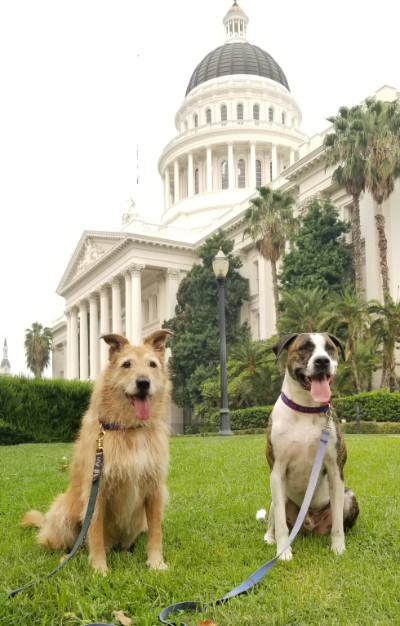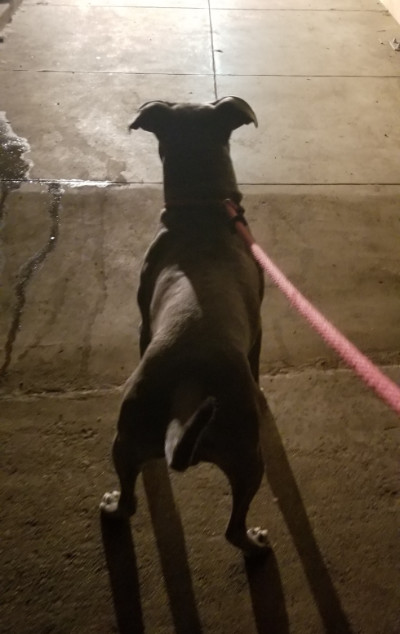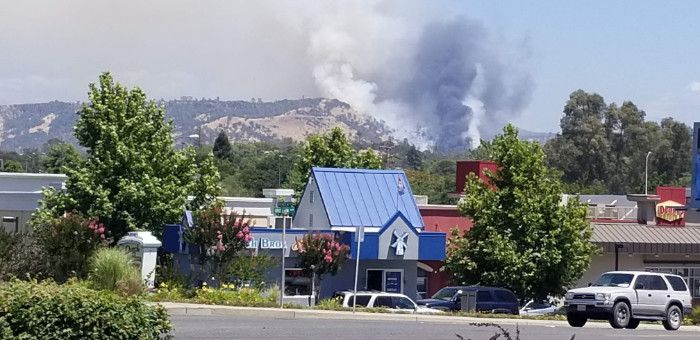If you have been following the weather news, you might have guessed what this post was going to be about, am I right?
So, we had a little dress rehearsal for fire season a month ago. Here in California, we had a unseasonal storm that featured a ton of thunder and lightning and ignited hundred of wildfires all over our state. One fire started fairly close to my home, which triggered evacuation warnings and caused my husband and I to go through our evacuation checklist and get prepared to evacuate. At that time, I also had to drive my grandson to an airport that is three hours away, so he could fly home to his mom after spending a good bit of the summer here, so my husband was left with the burden of being ready to load up the dogs and go if the fire blew up.
Fortunately for me, the very local edition of the lightning-sparked fire was extinguished pretty rapidly. Within a few days, it was a non-event.
Elsewhere in the state, though, lightning from the same storm ignited fires that grew and grew. Tens of thousands of people all over the state were displaced by the fires – forced to evacuate their homes with just what they could pack into their vehicles. Hundreds later learned they had no homes to return to.
Getting ready for an evacuation
Other fires that were sparked into being in mid-August smoldered quietly in very sparsely populated parts of the state until recently, when a freak windstorm blew several of them into monsters. My husband and I woke up several times in the night, hearing a strong wind blowing the trees around and smelling smoke more strongly than in recent weeks (the smoky sky had been persistent but not awful previously). We woke up with the news that the fire that had been burning about 40 miles from us was moving FAST in our direction. In a matter of hours, we learned that our area was being given a warning: be ready to evacuate.
Given the wind, I took the warning quite seriously. I filled up both our car and our truck with gas, got cash, and started staging things that the dogs would need if we had to evacuate: a big soft crate, dog food, bowls, leashes, poop bags, their vet records. I put on their collars, the ones with my phone number stitched into them. I had a foster puppy here, too – a pup who was found with a badly broken leg and, while staying with me, had surgery the previous week to amputate the not-reparable leg. I put his medications and Otto’s in the “to go” pile near the back door.
As the afternoon wore on and the news got increasingly dramatic, I took my work computer apart and loaded it and all my backup drives and cameras into a big plastic tub and put it in the car. All evening, I kept thinking of things I wouldn’t want to live without and putting them into a suitcase, just in case. The wind was so awful.
At 11 pm, all of a sudden my phone started screeching with an emergency warning: Our area was being ordered to evacuate. Now. Mandatory.
Even with all that prior preparation, it took my husband and I over an hour to load everything that we had staged into the car and truck. Part of it was the stress brought on by the urgency of the evacuation order; it’s amazing how shaky you can get when the thing you’ve been preparing so hard for suddenly happens. Part of it has to do with my husband’s OCD; he has to keep checking and checking his list to make sure we’ve done all the things he wanted to do before we left: water the oak trees we planted in the spring, pull anything flammable away from the house, make sure the sprinklers are set to come on every day while we are gone, check the locks on all the outbuilding, etc. As I waited for him with the dogs in the car, I texted with a friend who had offered a place for us to land about 20 miles away, and talked to my sister on the phone; she and her husband were evacuating in another direction, headed to our sister-in-law’s house.
As we drove down the back roads headed for the two-lane highway that leads to my town, so much ash was swirling through the air, it looked like snow in the headlights. Every so often, whole blackened leaves swirled through the ash, too. The black leaves scared us; if whole leaves that had been burned could be carried more than 10 miles by the wind, surely burning embers could, too?
We arrived at my friend’s house at around 1 am. We had brought a tent and sleeping bags, but my friend ushered us into a spare bedroom that was all made up for us – so sweet! She collected her four little dogs, each of whom is a rescue from my friend’s long career in animal sheltering and each of whom was barking like the fiercest protectors of the property; she locked them all in her bedroom (my apologies to her husband!). I set up a huge soft crate in the bedroom, and after letting them go potty outside, put my young dog, Woody, and the foster puppy in the soft crate together. Then I went to bring Otto in the house – whoops! He didn’t like the tile floor he had to cross to get into the bedroom, and didn’t like the sound of the four barking little dogs in the other room. I could read his mind: “Mom, I’d feel a lot better sleeping in our car.” And so I made him a nice bed on the back seat, with the windows cracked and a non-spill bowl of water.
When I got back into the house, my husband was in bed, and the puppy was sprawled, sound asleep, taking up far more than half of the huge soft crate. Though Woody often slept with the puppy at home, he didn’t seem to feel comfortable sleeping with the pup in the crate and he was sitting up, leaning miserably against the side of the crate, making a Woody-shaped bulge in the fabric. I unzipped the side zipper as quietly as I could, and he slithered out the side exit, leaving the foster pup sleeping soundly – an evacuation miracle! The pup had a big aversion to crates in general, which I had been working on by allowing him to chew on meaty bones and food-stuffed Kong toys only when he was in a crate, but he was still prone to kicking up a big fuss once his treat was over and he realized the door was closed. Even when we woke in the morning he was quiet!
When I took the puppy and Woody outside to let all three dogs go potty and to give them breakfast, I was shocked by how much ash had accumulated on every surface, just like snow would have.
The news of the fire was awful; it had traveled about 30 miles in the previous 20 or so hours and it had burned through several small communities. As of that morning, it was stopped about 7 miles from my sister’s house and 10 miles from mine. We wouldn’t be going home soon.

Next, we delivered the foster pup to his adoptive family; they had been prepared to take him the following week, once his stitches had been removed, but given the evacuations, this was going to work out better. And I’m a little embarrassed to report that we spent the next two nights in a nice hotel in the state capitol about an hour even farther away from the fire.
Relief: The dogs were perfect gentlemen in the hotel, though the hotel charged us a $100 “nonrefundable pet deposit,” an amusing oxymoron. They earned it though, because Otto left a considerable amount of red hair on the dark brown carpet. Also, the air was better (though still smoky), good enough to walk around the park that surrounds the state capitol building. Woody especially liked watching the squirrels that leap from tree to tree in the hundred-year-old trees in the park.
Just as we were having dinner in our room on the second night, I received a text: Our neighborhood was being downgraded to an evacuation warning again; we could go home. Comfortable as we were, and having already paid for the night, we stayed until the next morning.
Emergency animal shelters are no walk in the park
Well, it was a nice vacation of sorts. Time to get home and get to work – volunteer work at the emergency shelter set up to take in evacuated pets and animals that had been rescued by first responders from the fire. I had spent weeks and weeks helping care for dogs who were displaced by the infamous Camp Fire two years ago, and had taken the training sessions provided by the North Valley Animal Disaster Group (NVADG), the organization that runs the shelter. Several people I had met and worked with and had become friends with during the Camp Fire had already been hard at work at the emergency shelter; more than 150 dogs and at least 100 cats, bunnies, pet birds, and more were already at the shelter.

Emergency animal shelters are sort of like Red Cross shelters: People go to Red Cross shelters and have a place to sleep, to eat, and to be safe, but shelters are not exactly comfortable and can be crowded and stressful. Similarly, in emergency animal shelters, we keep all the animals safe and feed them, but the accommodations are similarly crowded and stressful. The animals are kept in wire crates, in some instances stacked two high, and positioned close together. It’s loud from the barking of stressed dogs and from fans. We position flattened cardboard boxes between the crates and use sheets to try to block the views of the ones who get triggered by seeing other dogs walk by, but there is a lot of barking no matter what we do.
There are two types of animals in the shelter: Those who were brought to the shelter for safe-keeping by families who had to evacuate, and those who were brought in by first responders. Sometimes people are looking for these “stray” animals, but sometimes, for whatever reasons, their owners don’t look for them and they end up getting sent to the regular county animal shelter like any other stray animal. And so the county needs to be prepared to care for a certain number of unclaimed animals for some time.
It takes a village to care for animals displaced by emergencies
It takes a small army of volunteers to manage to take care of all the animals’ most basic needs. The volunteers I’ve met are all extraordinary people, strongly committed to doing everything they can for the animals in the shelter. But, in the face of a local emergency, with many volunteers themselves displaced, with terrible, smoky air to breathe, and more animals to care for than there are volunteers to care for them, it never feels like a completely successful effort. I imagine that people who work with displaced human populations feel the same way; the need feels overwhelming, and trying to make uncomprehending animals comfortable in a situation that is completely uncomfortable for them is taxing.
Each dog needs to be taken from his or her crate and walked outdoors on a leash, while someone else cleans the crate, replaces the dog’s bedding, dumps any dirty water that is in the bowl, refills it, and dishes an appropriate amount of food into a food bowl or paper tray. Ideally, one person performs those tasks while two or three others walk the dogs. Each person who walks a dog makes notes on the dog’s chart: Did the dog go pee, poop, or both? Were any worms seen in the stool, or blood? If the dog had any signs of illness or discomfort – ear infection, lameness, sores, etc. – these are noted or their progress followed. If each dog is walked for about 10 minutes, a three or four person team can get out only about 18 to 24 dogs an hour. The numbers have been changing daily as some dogs are brought in and others are picked up, but in this disaster, there have been around 150 dogs being sheltered for over a week now.
All of this goes smoothly only with the help of even more people who are checking the shelter’s supplies of dog food, bedding, paper towels, zip ties, disinfectant and spray bottles, garbage bags, pens, you name it. People to haul away the giant garbage bags of refuse and poop bags. People to take away crates that have been broken and chewed through by large, anxious dogs and replace them with new crates. People to wash bowls. People to provide veterinary care and administer medications. People to follow the paperwork, to track down owners who are staying with relatives or friends or at human shelters. People to order food and drinks and ice (and masks) for all the volunteers, and haul away the trash after meals, too. It makes for very long days – and all under the emergency conditions, complete with weather that may or may not be cooperating, road closures, bad air, etc.
It’s incredibly humbling to learn that some of the people who are here to help are from other counties — and even other states. And that some are laboring at their regular jobs, and then coming to work another six hours after work to help. Incredible.
Many displaced animals come from underprivileged areas, and it shows
People who know California only by reputation might think it’s all urban and upscale. The fact is, where I live in far northern California, it’s rural and fairly low-income. Translate this to mean that some of the pets have had little in the way of routine veterinary care. Most of the dogs are mixed-breeds; many are intact. Many of the dogs have fleas and flea-allergy dermatitis. Some dogs are way too thin; some are way too fat – like, if they were humans, they’d weigh 400 pounds. There are 4-month-old pups who are terrified of humans and can’t be touched, and 14-year-old dogs who have to be carried to go potty. There are some fit, healthy dogs, too, but they don’t stick in our brains the way the sad dogs do. It gives us a little relief to take a few extra minutes to lavish a little extra care on some of these dogs – rooting through the piles of donated blankets and towels for extra thick ones for the sore, old dogs to sleep on at night, or hunting through the donated foods for better ones to give the extra skinny dogs. Again, I imagine this is similar to how people who work or volunteer in human shelters must feel – that the need for help is overwhelming.
Coming home to our clean, well-fed dogs, sleeping on their extra thick beds in the house, feels so strange after triaging these underprivileged dogs.
I know that not everyone lives in an area where they are subject to the specific danger of wildfires – but just about everyone lives somewhere that experiences some form of natural disaster occasionally, whether it’s flooding, tsunamis, earthquakes, hurricanes, tornadoes, or that wind/rain thing that happened in Ohio recently. I implore everyone I know to prepare for the possibility of having to leave their homes with their pets in case of emergency. Bring or keep your animals with you if you possibly can. Cultivate a network of friends or family members who live at a reachable distance (but not so close that they are in the same boat as you in case of a disaster), and offer them mutual aid; if they need help, help them, and vice versa. And if you are able to do those things in a disaster, and can possibly help people who don’t have these resources, please do. Find out when your local animal aid organizations offer new volunteer orientation and training so that you know how to best help when a disaster strikes. There are national organizations, both nonprofit (such as the ASPCA) and governmental (FEMA) that offer online courses that meet the training requirements for some aid agencies. The ASPCA has a great list of training opportunities here. If my experience is any guide, I can guarantee that you will meet some really amazing folks who are also helping.







Thanks for writing this and giving us a status update. I remember the notes you wrote the last time there was a lot of fire in your area and was concerned that history was repeating itself. I’m hoping that the situation dies down and that you and your dogs and human family will be OK.
Wow Nancy, amazing story. YOU are amazing and the many volunteers you mentioned. I had a laugh at “nonrefundable pet deposit,” yes, we’ve had that too. My husband told them to just call it what it was, a fee. Take care, and stay safe!
I have been thinking of you so am so glad and relieved to hear what has happened since your last post.
As always, great admiration for your commitment to the four leggeds.
Glad you & yours (husband, dogs) are safe. So many arent and I’m sure there are untold numbers of animals – dogs, cats & large animals that their owners couldnt take with them. The worry for missing family members and animal family members has to be awful.
I hope & pray this “season” of fires comes to an end soon. Maybe rain possibly?
Thanks for sharing this! I have family and friends in the Santa Cruz mountains, S. Oregon and Washington who are in the same situation. May you and your community be safe and well.
We are in western Oregon – enough said, the news says it all. We were only at Level 1 so agreed to take in a small flock of evacuated chickens in our unused coop; the chickens were seemingly unfazed by all of the stress, smoke, heat and extremely stressed humans. However, same owner of the chickens had a GSP, young dog, intact male, with severe separation anxiety (the owner had NO idea what canine separation anxiety is, she thought he was “just noisy.” We put him in one of the unused horse stalls in the barn because she advised he could not be trusted in the house. Within an hour after the owner left he had worked himself into such a frenzy including throwing his body against the stall walls that I had to call the owner, who at that point was trying to get some valuables out of her house before the OSP stopped letting people back into the neighborhood. Well – she had to give up her idea of staying at a hotel while evacuated and decided just to camp in her truck with her dog. I hope at some point when this emergency is over she will start learning how to work with a dog who has severe separation anxiety – before the NEXT wildfire emergency happens as we are informed this is the “new normal” for Oregon.
Hi the article is very good thank you for all the information…
Thank you so much for the information! May you have a nice weekend!
Chills and tears – stay safe, my friend…
What a story- thanks to you and all the volunteers who reach out to these poor ones. Have you ever thought of the music CD’s made for dogs to help relieve stress? Through a Dog’s ear has worked wonders for many of the dogs I sit for while their families travel.. The music is scientifically made for dogs- and it works. I first tried it in my car when my rescue, Grizzlie, went wild at winshield wipers. I wish more shelters would try it..